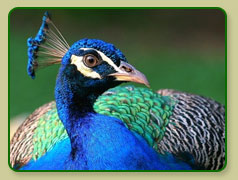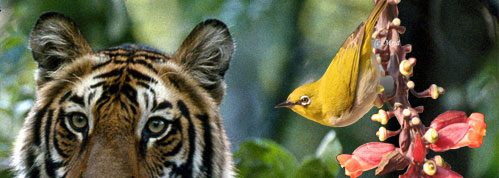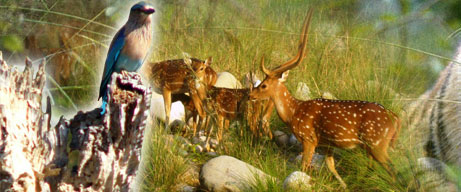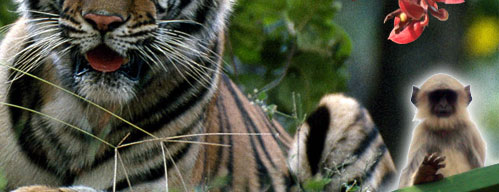Wild Species In India
Indian Peacock
Physical Features
The male Indian Peafowl, commonly known as the peacock, is one of the most recognisable birds in the world. These large, brightly colored birds have a distinctive crest and an unmistakable ornamental train. The train (1.4-1.6 meters in length) accounts for more than 60% of their total body length (2.3 meters). Combined with a large wingspan (1.4-1.6 meters), this train makes the male peafowl one of the largest flying birds in the world. The train is formed by 100-150 highly specialized uppertail-coverts. Each of these feathers sports an ornamental ocellus, or eye-spot, and has long disintegrated barbs, giving the feathers a loose, fluffy look. When displaying to a female, the peacock erects this train into a spectacular fan, presenting the ocelli to their best advantage.
Diet of Indian Peacock
Indian Peafowl do most of their foraging in the early morning and shortly before sunset. They retreat to the shade and security of the forest for the hottest portion of the day. Foods include grains, insects, small reptiles, small mammals, berries, drupes, wild figs, and some cultivated crops.
Habitat & Diet of Indian Peacock
The Indian Peafowl is not endangered species in subcontinent. It is frequently found in India and neighboring countries like Bangladesh, Sri Lanka and Nepal in Himalayan regions. They live in large heard in open forests, banks of rivers and streams, orchards and stream side forests. As their food, they take grains, insects, small reptiles, small mammals, berries, drupes, wild figs and some cultivated crops.
Spotting the Peacock
If you are really want to watch our this beautiful national bird, you can watch them in any part of the country. Even, on the side of your road and far in the fields from your vehicle, they can be seen in full majesty. Following sanctuaries are known for harboring a large heard of peacock. Must watch them during your visit to these sanctuaries.

- Family : Phasianidae
- Eating Habit : Omnivorous
- Blue Peacock : Pavo cristatus (found in India and Sri Lanka)
- Green Peacock : P. muticus (found in Burma and Indochina)
- Congo Peacock : Afropavo congensis (found in the Congo basin in Africa)
- Major Sites : Indus river, Jammu and Kashmir, east Assam, south Mizoram and the whole of the Indian peninsula.
Physical Features
The male Indian Peafowl, commonly known as the peacock, is one of the most recognisable birds in the world. These large, brightly colored birds have a distinctive crest and an unmistakable ornamental train. The train (1.4-1.6 meters in length) accounts for more than 60% of their total body length (2.3 meters). Combined with a large wingspan (1.4-1.6 meters), this train makes the male peafowl one of the largest flying birds in the world. The train is formed by 100-150 highly specialized uppertail-coverts. Each of these feathers sports an ornamental ocellus, or eye-spot, and has long disintegrated barbs, giving the feathers a loose, fluffy look. When displaying to a female, the peacock erects this train into a spectacular fan, presenting the ocelli to their best advantage.
Diet of Indian Peacock
Indian Peafowl do most of their foraging in the early morning and shortly before sunset. They retreat to the shade and security of the forest for the hottest portion of the day. Foods include grains, insects, small reptiles, small mammals, berries, drupes, wild figs, and some cultivated crops.
Habitat & Diet of Indian Peacock
The Indian Peafowl is not endangered species in subcontinent. It is frequently found in India and neighboring countries like Bangladesh, Sri Lanka and Nepal in Himalayan regions. They live in large heard in open forests, banks of rivers and streams, orchards and stream side forests. As their food, they take grains, insects, small reptiles, small mammals, berries, drupes, wild figs and some cultivated crops.
Spotting the Peacock
If you are really want to watch our this beautiful national bird, you can watch them in any part of the country. Even, on the side of your road and far in the fields from your vehicle, they can be seen in full majesty. Following sanctuaries are known for harboring a large heard of peacock. Must watch them during your visit to these sanctuaries.
- Bharatpur Bird Sanctuary
- Dandeli Wildlife Sanctuary
- Kaziranga National Park
- Viralimalai Wildlife Sanctuary
- Thattekad Bird Sanctuary
- Kumarakom Bird Sanctuaries
- Kadalundi Bird Sanctuary
- Overa Wildlife Sanctuary
- Nalsarovar Bird Sanctuary
- Sultanpur National Park



